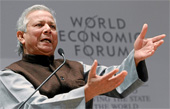Innovation From the Inside Out
Nurturing a new and lasting idea doesn’t result from analyzing market data. Aspiring creators must act on what nonprofits already know: you get the best answers by burying yourself in the questions.

Image courtesy of the World Economic Forum.
Before Muhammad Yunus decided to start the innovative bank that would upend conventional wisdom and deliver affordable credit to the rural poor, he didn’t conduct grass-roots market research or consult a global positioning system for the best target markets. Certainly, he knew enough to compile such data; he was, after all, a highly trained economics professor. But the inspiration that led to Grameen Bank’s launch in 1976 came not from the depths of an ocean of market data, but from a personal bond and shared vision built by Yunus and the Bangladeshi farmers living in the village adjacent to Yunus’s home and university.
That shared vision came into focus as Yunus and the villagers spent time together as a community: in the rice fields in farming projects, in afternoon conversations at roadside tea stalls, and in late-evening dinners and debates. By working together and learning from one another, Yunus’s and the villagers’ unique knowledge, insights and perspectives came into creative collision, sowing the seeds for a profitable and scalable village banking model that neither could have conceived of independently. In time, Grameen Bank would profitably serve more than seven million women borrowers across some 75,000 villages of Bangladesh, with annual loan disbursement exceeding $800 million.1
More than two decades later, another experiment began taking root. Motivated in part by the success of Grameen Bank, several corporations began to test the theory that an untapped, multitrillion-dollar consumer market could be found at the “base of the economic pyramid” or BoP — the four billion people with annual per capita incomes below $1,500 (purchasing power parity).2 One of the companies at the forefront of this movement has been Hindustan Unilever Ltd., formerly known as Hindustan Lever Ltd., the Indian subsidiary of the Dutch consumer products multinational Unilever N.V. In 2000, with $23 million in seed capital, HLL launched Project Shakti (translated as “sacred force” or “empowerment”) to tap India’s vast, geographically dispersed rural population of villagers.
References
1.For a history of Grameen Bank, see M. Yunus, “Banker to the Poor: Micro-Lending and the Battle Against World Poverty” (London: Aurum Press, 1998).
2.For the first articulation of this idea, see C.K. Prahalad and S. Hart, “The Fortune at the Bottom of the Pyramid,” Strategy+Business 26 (2002): 54-67. For recent efforts to quantify the potential economic value of this demographic, see A. Hammond, W.J. Kramer, J. Tran, R. Katz, and C. Walker, “The Next 4 Billion: Market Size and Business Strategy at the Base of the Pyramid” (Washington, D.C.: World Resources Institute, 2007).
3.V.K. Rangan and R. Rajan. “Unilever in India: Hindustan Lever’s Project Shakti — Marketing FMCG to the Rural Consumer,” Harvard Business School case no. 9-505-056 (Boston: Harvard Business School Publishing, 2005, rev. 2007).
4.K. Polanyi, “The Great Transformation: The Political and Economic Origins of Our Time” (New York and Toronto: Farrar & Rinehart, 1944).
5.See T.A. Stewart, “The Great Wheel of Innovation,” Harvard Business Review 84 (November 2006): 14.
6.For more information on the history of Mondragón, see W.F. Whyte and K.K. Whyte, “Making Mondragón: The Growth and Dynamics of the Mondragón Cooperative Complex” (Ithaca, New York: Cornell University Press, 1988).
7.For a detailed explanation of the BoP Protocol process, along with examples from the DuPont and S.C. Johnson initiatives, see E. Simanis and S. Hart, “The Base of the Pyramid Protocol: Toward Next Generation BoP Strategy,” 2nd ed., 2008, www.johnson.cornell.edu/sge/research/bop_protocol.html. A BoP Protocol Field Guide outlining specific tools and techniques will be completed in 2009.
i.M. Wackernagel and W. Rees, “Our Ecological Footprint: Reducing Human Impact on the Earth” (Gabriola Island, British Columbia: New Society Publishers, 1996).
ii.A. Sawhney, “The New Face of Environmental Management in India” (Aldershot, United Kingdom: Ashgate Publishing, 2004).

Comments (2)
mikenorman
plnarasimhan